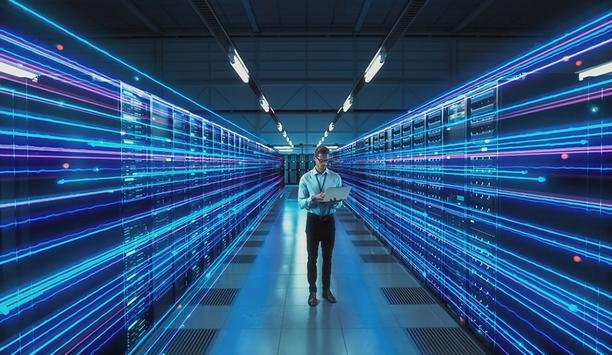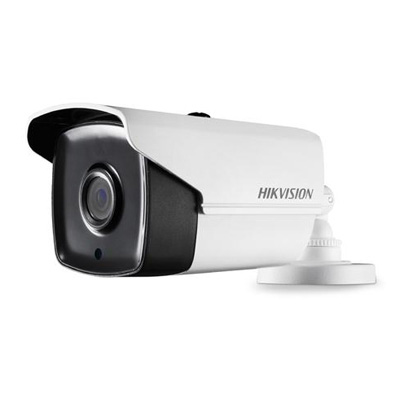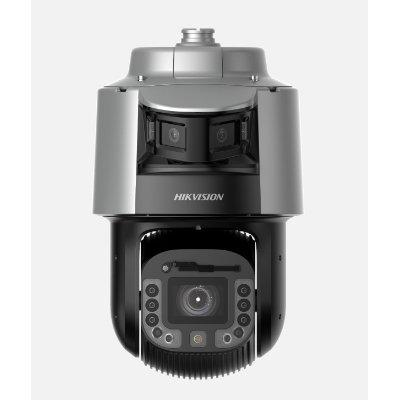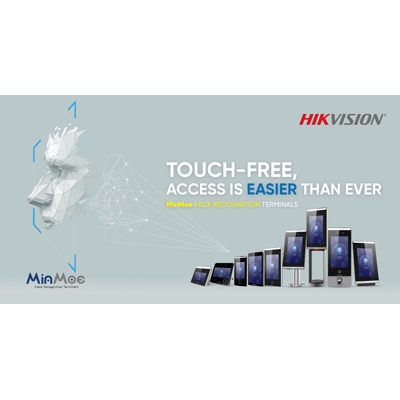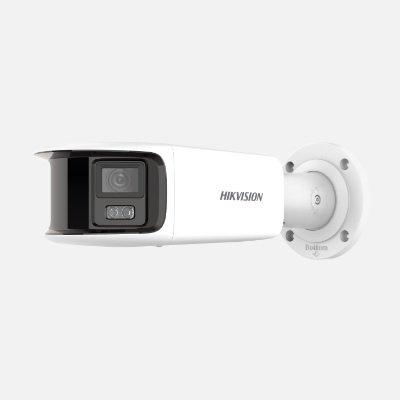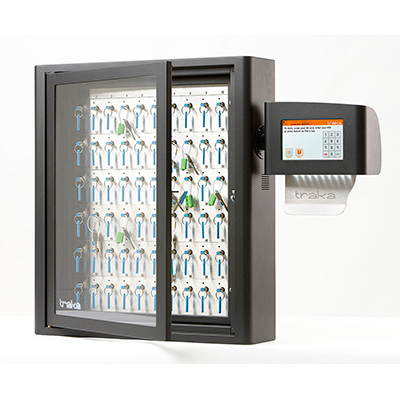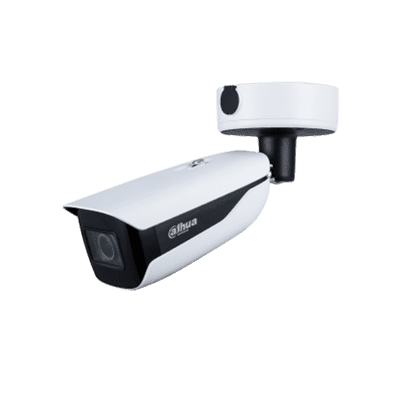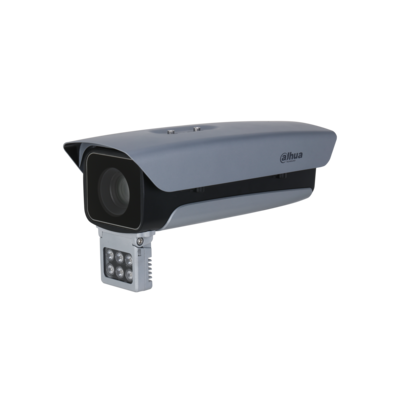Biometric Security
Hanwha Vision, the global vision solution provider, has unveiled the Dual-Lens Barcode Reader Camera, with models TNS-9040IBC, TNS-9050IBC, and TNS-9060IBC, to combine barcode recognition and video capture in one device. In combination with the Vision Logistics Tracking Software, barcodes, and video are provided in real-time to enhance inventory management, traceability, and incident investigation, reducing shipping errors, and returns, and ultimately boosting customer satisfaction. ...
Robotic Assistance Devices (RAD), proudly announces the launch of SARA™ (Speaking Autonomous Responsive Agent). This innovative software solution is poised to redefine security monitoring, offering unparalleled efficiency and cost-effectiveness, while reshaping how Global Security Operations Centres (GSOCs) operate. Security operations Centre A typical security operations centre relies on human workers to review video footage escalated by analytics, assess the situation, and decide...
Gcore, the global edge AI, cloud, network, and security solutions provider, and Ezditek, an innovator in data centre and digital infrastructure services in the Kingdom of Saudi Arabia (KSA), have launched a joint venture focused on providing high-performance AI infrastructure in the KSA. The joint venture will develop an ‘AI factory’, which can be used for building, training, and deploying generative AI solutions locally and across the globe. Ezditek’s...
Hopae, makers of the world’s most advanced digital identity solution, announced $6.5 million in funding as the company introduces its proprietary, patented Digital Credential eXpress (DCX) architecture to the U.S., simplifying the complex world of decentralised ID (DID) implementation. Hopae helps governments and institutions issue reusable, privacy-preserving, and unforgeable digital IDs and credentials. Its expansion and funding news comes as companies seek to comply with new inter...
Altronix, the recognised pioneer in power and data transmission for the professional security industry, is showcasing its expanded lineup of industry-proven technologies at ISC East 2024 in booth 713. The expanded product portfolio further addresses the evolving needs of security professionals, offering robust solutions for access control, video surveillance, fire, and network management, designed to streamline deployment and better protect critical infrastructure. Data transmission solutions...
Bugcrowd, the pioneer in crowdsourced security announced an alliance with Least Authority, a Berlin-based pioneer in secure use of advanced cryptographic techniques. Least Authority provides customised services to support FinTech and Web3 products through design and development, including code audits, specification reviews, and system architecture assessments. Research and development The company specialises in the research and development of distributed systems, blockchain protocols, AI/ML a...
News
IDScan.net, the pioneer in AI-powered identity verification technology, proudly announces a year of significant growth in 2024. This success has been driven by product innovation, increased efficacy in the detection of fake IDs, strategic hires, and the establishment of new partnerships, further solidifying IDScan.net’s position as a pioneer in ID scanning and identity verification. Flagging fake and synthetic IDs The organisation has capitalised on growing ID fraud across a variety of industries, as fraudsters look to swindle businesses such as dispensaries, car dealerships, big box retailers, manufacturers, and others by using fraudulent credentials. Across IDScan.net’s products, they flagged more than 600,000 fake IDs and synthetic identities in 2024. Growth revenue and verification volume The rising threat of ID fraud has led to more than just growth in revenue and verification volume. In 2024, IDScan.net has also: Grown total customers by 19%. Earned 17 badges from G2, including Best ROI, Highest Customer Satisfaction, and Most Effective. Launched mobile ID acceptance in both VeriScan for iOS and VeriScan for Windows. Spoken at conferences such as HITEC and GSX on trends in mobile ID adoption. Best SaaS Provider The awards are a testament to IDScan.net's cutting-edge advancements in AI-powered identity verification Additionally, IDScan.net was named the Best SaaS Provider at the 2024 Global Tech Awards, and Senior Product Manager, Hannah Ligon was awarded Bronze for Most Innovative Woman of the Year in the Stevie Awards. These awards are a testament to IDScan.net's cutting-edge advancements in AI-powered identity verification technology, the strength of the team, and its significant impact on enhancing security and compliance across various industries. New strategic hires This expansion is supported by ten new strategic hires aimed at enhancing customer support and business development. Notable additions to the team include Dan Kelleher as the new Vice President of Operations, who previously spent 30 years in the finance department of Hertz, and Ayna Verella Lawson, who joins the team after working on identity-related projects at Capital One. Product enhancements Also notable was the launch of ParseLink, a successor to the popular legacy product “WizzForms” Product enhancements have been at the forefront of IDScan.net's 2024 strategy. This innovation has centered around improving the efficacy of fake ID detection, especially tampered and photoshopped IDs, as well as improved BI and analytics for multi-location customers who need a birdseye view into fraud risks across large, distributed organisations. Also notable was the launch of ParseLink, a successor to the popular legacy product “WizzForms” which allows ID data to be automatically ingested into any form or software. Reduce the risk of scams “2024 has been an outstanding year of growth for our business,” said CEO, Terry Slattery. “We have focused on our core mission - to help businesses reduce the risk of scams using fake IDs - with incredible results. We expect to carry the momentum from this banner year forward into 2025 and beyond.” Shifts in ID fraud and identity verification Synthetic identity fraud is projected to become the major type of fraud, mirroring economic pressures Looking ahead to 2025, IDScan.net anticipates significant shifts in ID fraud and identity verification. As mobile IDs continue to roll out, with eight states expected to launch in 2025, the challenge remains for businesses to adapt to these technological advancements. Synthetic identity fraud is projected to become the major type of fraud, mirroring economic pressures that historically correlate with rises in ID fraud. Decentralised identity systems Additionally, societal concerns about AI may prompt anti-deepfake legislation, while discussions around age-restricted access to digital content are likely to intensify, posing implementation challenges. The move towards decentralised identity systems will also gain traction, offering users enhanced control over their data.
inter airport Southeast Asia, the premier trade exhibition and conference for airport innovation and technology in Asia will return to Singapore from 25 to 27 March 2025 at the Marina Bay Sands. The 8th edition is expected to bring together over 3,500 representatives of the aviation industry in Asia, influencers in the airports and airlines community, and 150+ exhibitors, including world-class solution providers and airport equipment suppliers, to connect, find synergies, build partnerships, and innovate. Sustainable solutions As the aviation industry advances and new airport projects and investments surge globally, groundbreaking innovations are essential to drive its transformation. Themed “Airport Operations for Tomorrow” conversations at the exhibition and conference will highlight innovation, technology, and sustainable solutions to optimise terminal and ramp operations of the future. Asia driving majority in airport projects APAC currently boasts 575 existing or new airport projects, valued at a staggering USD 488 billion With visitor arrivals projected to reach 564 million in the Asia Pacific, the region is positioned at the forefront of significant airport development, leading the global aviation recovery. APAC currently boasts 575 existing or new airport projects, valued at a staggering USD 488 billion, while the investment at existing airports amounts to 170 projects, valued at USD 217 billion. Passenger volume “Thailand is one of the high growths in emerging aviation market in Asia-Pacific. The passenger volume is expected to double by 2032, and Thailand will be one of the top 10 markets in total passenger traffic by 2042,” said Latchida Apaphant, EVP, Foreign Affair, Airports of Thailand PLC (AOT). "To manage the increased passenger capacity, AOT developed a strategic master plan that includes the construction of new airports, expansion of existing facilities, and upgrades to key infrastructure to enhance capacity to accommodate 240 million annual passengers (MAP) by 2032." Automated technology and biometric identification “To make Thailand a regional aviation hub, and a goal to bring Suvarnabhumi International Airport rank among the top airport operators by 2037, massive investments are also be made to procure automated technology and biometric identification system to reduce international passenger processing times." "Given the increasing complexity of airport operations and the need to innovate, inter airport Southeast Asia conference offers timely discussions and an exhibition to explore emerging technologies for the future of airports.” Speakers at the conference Ms. Latchida will join some of the C-suite speakers confirmed at the inter-airport Southeast Asia conference: Ricia Montejo, Head, Customer Experience, Aboitiz GMR-Megawide Cebu Airport Corporation Ibrahim Mohd Salleh, Chief Operating Officer, Aerodarat Services Sdn Bhd - a wholly owned subsidiary of Malaysia Aviation Group Lye Teck Tan, EVP, Safety & Security, Changi Airport Group Saurabh Dalvi, Head of Operations, Mumbai, Goa, Hyderabad, Celebi Nas Musdalifa Abdullah, CEO, GTR Malaysia Megat Ardian, Senior General Manager, Strategy, Malaysia Airports Raymond Lo, CEO, Menzies CNAC Aviation Services Ltd Simon Lotter, Head of Market for Asia & Pacific, Munich Airport International Tatsuya Izumi, Deputy General Manager, Narita International Airport Corporation Ranjiv Ramanathan, SVP, SG Hub Transformation & Development, SATS Ltd Brad Moore, CEO APAC, Swissport International AG The reference point for the future of airports According to Airports Council International (ACI), global passenger volume is foreseen to reach 9.5 billion in 2024, while the Asia-Pacific region is said to lead in year-on-year (YoY) growth in 2024, with a 13% increase, reaching 3.4 billion passengers by year-end. With air travel playing a vital role in global trade and tourism, the sector must adopt innovative approaches to make airports more sustainable and resilient. Efficiency and greener solutions Global and regional solutions that support the scaling up of airport tech to boost operation efficiency inter airport Southeast Asia 2025 will highlight global and regional solutions that support the scaling up of airport tech to boost operation efficiency and greener solutions in ground operations to reduce carbon emissions. Prominent exhibitors on the exhibition front include ADB Safegate, Alstef Group, BSLBatt, Charlatte Manutention – FAYAT Group, Dynell GmbH, ElectroAir, Fastcharge GSE, ITW GSE, JBT AeroTech, Runway Safe Group, Roypow, Smith Detection, TLD Asia Ltd, Weihai Guangtai Airport Equipment, just to name a few. Reduce emissions and improve operational efficiency “Ground support equipment is a critical component of driving airport operations, and the advancements in GSE technology are paramount for driving sustainability and efficiency,” said Brad Moore, CEO – of APAC, Swissport. "By embracing advanced GSE technologies, such as electric and autonomous vehicles, we can reduce emissions and improve operational efficiency, all while enhancing safety. It’s important to discuss how we can reimagine ground handling operations to establish new benchmarks in turnaround efficiency, and I’m excited to discuss this with fellow panelists at the upcoming inter-airport SEA." Japan pavilion Japan pavilion will also be showcased for the first time at inter-airport Southeast Asia. The pavilion will present a dynamic line-up of companies including NEC, Japan Radio Co., Ltd (JRC), RION, ShinMaywa Industries, Ltd., Sugie Seito Co., Ltd., and Toyota Industries Corporation as they showcase cutting-edge airport equipment for ground operation and touchless technology to enhance airport experiences. Singapore in advanced aerospace manufacturing standards The standard seeks to establish a comprehensive framework for FLM parts producers In line with the industry's focus on innovation and safety, Singapore is also taking steps to advance aerospace manufacturing standards. A Working Group on Additive Manufacturing for Aerospace Manufacturing, established under the Singapore Standards Council, will launch a new standard: SS 708 Additive Manufacturing (AM) for Aviation – Filament Layer Manufacturing (FLM) Process Specifications. The standard seeks to establish a comprehensive framework for FLM parts producers supplying to the aerospace industry, covering process control and qualification of hardware, facility, materials, and operations. inter-airport Southeast Asia 2025 The standardisation of terminology and processes will also facilitate procurement officers of FLM parts to better evaluate new industry entrants to the FLM supply chain, ultimately contributing to enhanced safety in both commercial and military aircraft operations. All registered professionals for inter-airport Southeast Asia 2025 will be granted free access to both the exhibition and conference floors.
IDEMIA Public Security North America, the market-renowned provider of solutions for Motor Vehicle Agencies, in partnership with the Tennessee Department of Safety and Homeland Security (TDOSHS), has launched its new self-service kiosks at Tennessee Driver Service Centres to reduce customer wait times. Tennessee residents can use IDEMIA’s SMART-E Kiosks to complete many driver's licence transactions, including renewing or replacing a duplicate driver’s licence or ID card, changing an address, updating emergency contact information, advancing a Teen/Graduated Driver Licence, paying reinstatement fees, and requesting a licence reissue after reinstatement requirements are met. Web Enrolment platform IDEMIA’s next-generation kiosk, the SMART-E, has been redesigned for motor vehicle agencies IDEMIA’s next-generation kiosk, the SMART-E, has been redesigned for motor vehicle agencies, offering self-service options built on the same industry-renowned browser-based Web Enrolment platform used by examiners to capture customer data, photo, signature, and payment. With cloud-hosted Issuance 360 Back Office providing integration with the State System of Record on the backend, users can enjoy a seamless solution that spans industry-renowned customer service at examiner workstations, and flexible and efficient self-service, along with many great benefits: Easy to Use and ADA-Compliant: Easy-to-follow instructions over two screens for dynamic workflow and privacy protection. ADA-compliant audio navigation via speaker or audio jack. Flexible Placement: Easily deployed wherever power and ethernet connection is available, with the option of space-saving, back-to-back arrangement. Configurable Workflow: Offers flexibility to be used with agent assistance (“Attended Mode”) or as self-service (“Unattended Mode”). ICAO-Compliant Photos with Automatic Height Adjustment: Photo capture for seated or standing customers with a 13 MP autofocus camera. Automatically crops to ICAO and AAMVA standards and performs ICAO quality compliance checks. Upfront Eligibility Check: Uses 1:1 facial recognition to compare against the photo on file and determine eligibility for self-service transactions. New self-service kiosks "We are excited about the added flexibility and convenience the new self-service kiosks will provide for Tennesseans. Citizens can complete many Driver Services transactions at one of these new kiosks, which will help reduce wait times at Driver Services Centres," said TDOSHS Commissioner, Jeff Long. "We are thrilled to launch our new self-service kiosks in the state of Tennessee. With our commitment to serve Motor Vehicle agencies across the country, we are excited to bring this solution to help Tennessee Driver Services Centres bring an efficient, convenient, and seamless experience to their customers who come into their offices," said Donnie Scott, CEO, IDEMIA Public Security North America. Other advanced DMV solutions In addition to IDEMIA’s self-service kiosks, IDEMIA serves Tennessee residents with other advanced DMV solutions, including mobile travel cases, physical driver’s licences, facial recognition, remote web test, proctor ID (at home testing), and front office/capture equipment. On top of IDEMIA’s advanced DMV solutions, IDEMIA also provides Tennessee residents access to statewide enrolment services, Automated Fingerprint ID System (AFIS), LiveScan Devices, Morpho/Mobile IDent 2.0, U.S. Citizenship and Immigration Services, Checkpoint Identity Authentication, and TSA PreCheck.
According to the 2024 Access Control report by Omdia, Genetec., the pioneer in enterprise physical security software, has consistently gained market share over the last six years, solidifying its position as a worldwide market pioneer and building upon its #2 global position for access control software. In the Americas market, access control software has evolved beyond the physical security department to become an essential component of business operations. 2024 Access Control report According to the Omdia report, this broader adoption has increased demand for unified security platforms that allow organisations to manage systems - such as access control, video surveillance, and intrusion detection - through a single interface. By anticipating market needs for access control innovation, Genetec continues to expand its market share, growing at a 28% CAGR over the past six years. Access control innovation “While many legacy access control vendors rely on acquisitions to expand their market share, Genetec has achieved rapid organic growth through innovation and investment in new technologies,” said Christian Morin, Vice President of Product Engineering, Genetec Inc. Christian Morin adds, “Over the last year, we introduced Security Center SaaS, HID Mercury Security MP controllers, Axis Powered by Genetec, and an I/O module in partnership with STid as part of our European high assurance access control system offering. This demonstrates our commitment to expanding our access control portfolio through innovation and partnerships, paving the way for future growth.” Providing adaptable solutions Omdia also reports that end users in the region prefer open systems that offer flexibility and customisation In a highly fragmented EMEA market, Genetec remains among the top 10 access control software providers by focusing on open architecture systems that allow users to integrate components from different vendors. Omdia also reports that end users in the region prefer open systems that offer flexibility and customisation. This further supports the company’s strategy to provide adaptable solutions tailored to the region, as evidenced by its partnership with STid. Strong integration capabilities In the Asia-Pacific region (excluding China), Genetec continues to rapidly expand its market share, reaching #6 position (up from #10 in 2021). As enterprise users and multinational corporations modernise their access control infrastructure, they seek feature-rich, cyber-secure systems with strong integration capabilities. An open-architecture solution, such as the Genetec access control solution, allows organisations to secure assets and people, enhance business operations, and easily upgrade technology at their own pace. Full cloud deployments Genetec has retained its #1 global position in the VMS market while also ranking #1 in the combined VMS The Omdia report also indicates that the access control market is increasingly adopting hybrid cloud deployments. Genetec is at the forefront of this change. Security Center SaaS is a physical security solution that brings the power of Genetec access control and video management to the cloud. Security Center SaaS supports hybrid or full cloud deployments, allowing organisations to move components and sites to the cloud based on their needs and requirements at their own pace. Genetec solutions Because Genetec solutions are based on an open platform architecture, users choose the access control devices that best suit their needs while also preserving their existing investments. In addition to its success in access control, Genetec has retained its #1 global position in the VMS market, while also ranking #1 in the combined Video Management Software (VMS) and Video Surveillance as a Service (VSaaS) market, according to Omdia’s recently released 2024 Video Surveillance & Analytics Database Report.
Interface Systems, a globally renowned managed service provider of security, actionable insights, and purpose-built networks for multi-location businesses, has released its 2024 State of Remote Video Monitoring in Retail Chains report. The detailed study analysed over 2 million monitoring requests across 4,156 retail locations in the United States from September 2023 to August 2024. Offering valuable insights to strengthen store security and protect employees, the report provides an overview of the critical challenges faced by retailers. It highlights the peak times for security incidents, the importance of interactive monitoring, and the effectiveness of advanced technologies, such as video verification and voice-down commands. Voice-down interventions "This report underscores the critical role that data-driven security strategies play in safeguarding retail environments. By leveraging interactive monitoring solutions, retail chains can effectively mitigate risks, reduce false alarms, and ensure a safer experience for both employees and customers," said Brent Duncan, CEO of Interface Systems Key findings include: Theft, Disturbances, and Loitering Dominate Security Incidents - The report identifies theft, disturbances, and loitering as the most common security threats in retail locations. Loitering incidents, in particular, led to the highest rate of police dispatches at 65.8%. Critical Times for Store Security - The data reveals that peak security risks occur during store closing times, particularly between 5:00 p.m. and 8:00 p.m. when dispatch rates are the highest. Early morning and late-night hours see minimal incidents, indicating a reduced need for escalation during these times. Highly effective deterrent By providing real-time access to remote security professionals, stores can efficiently manage incidents Effectiveness of Video Verification and Voice-Down Commands - Stores utilising video verification saw a 97% reduction in false alarms, significantly minimising unnecessary dispatches and associated penalties. Voice-down interventions proved to be a highly effective deterrent, resolving over 99.86% of incidents without requiring police involvement, reinforcing the value of real-time audio deterrence. Impact of Interactive Monitoring Solutions - The deployment of interactive monitoring solutions has proven to be effective in enhancing security and employee confidence. By providing real-time access to remote security professionals, stores can efficiently manage incidents, especially during high-risk periods like store closings. Interactive monitoring solutions Tyson Johns, SVP of Security Monitoring Operations at Interface Systems, emphasised, "Our data reveals actionable patterns that retail chains can leverage to deploy more effective loss prevention strategies." Tyson Johns adds, "The significant reduction in police dispatches through our interactive monitoring solutions demonstrates the power of technology in maintaining a secure environment."
IT services provider - adesso has been admitted into the Crown Commercial Service (CCS) Cloud-14 framework, supporting the UK’s public sector in its journey toward secure, streamlined, and efficient digital transformation. The Cloud-14 framework facilitates access to IT services for government organisations, empowering them to innovate, strengthen data security, and scale services to meet public needs more effectively. Innovative solutions adesso delivers innovative solutions that enhance the digital capabilities of public sector organisations With this recognition, adesso is positioned to deliver innovative solutions that enhance the digital capabilities of public sector organisations, ensuring faster response times, improved service delivery, and robust infrastructure to benefit citizens nationwide. Achieving this milestone required six months of rigorous preparation and collaboration, with teams across adesso with focus a on compliance, transparency, and excellence. Secure digital transformation The process highlights the company’s ability to set new standards for fostering secure digital transformation, both locally and globally. Libero Raspa, Managing Director of adesso UK, commented: “Securing a place on the CCS Cloud-14 framework marks a pivotal moment for adesso, reflecting the collective dedication, expertise, and passion of our team. It is a testament to our commitment to empowering the UK’s public sector with tailored, innovative solutions designed to address the evolving demands of digital transformation.” Cloud-14 framework Libero Raspa added: “This achievement also underscores the growing importance of collaboration and transparency in delivering impactful digital outcomes. As we move forward, we remain focused on providing solutions that not only meet immediate operational needs, but also lay a foundation for long-term resilience, adaptability, and sustainable progress.” adesso’s inclusion in the Cloud-14 framework marks a significant step forward in its mission to partner with government organisations in shaping a digitally resilient future. The company is committed to delivering tailored IT solutions that address evolving public sector challenges, ensuring that technology serves as a force for the public good.


Expert commentary
The artificial intelligence revolution in physical security has arrived, transforming how we protect people, assets, and infrastructure. From smart buildings that automatically adjust access protocols based on real-time threat assessments to healthcare facilities using AI-enhanced video analytics for patient safety, these technologies are reshaping the industry landscape. But with this transformation comes a new era of regulatory oversight that security professionals must navigate carefully. Convergence of AI The convergence of powerful AI capabilities with traditional security systems has created unprecedented opportunities for enhanced protections while simultaneously raising important questions about privacy, transparency, and responsible deployment. As these technologies become more sophisticated, security professionals face the dual challenge of maximising their potential while ensuring compliance with evolving regulatory frameworks. The current state of AI in security systems By combining multiple data streams, AI creates a more comprehensive and intelligent security ecosystem Today's AI-driven security solutions extend far beyond traditional security capabilities. Modern systems can understand complex human behaviours, analyse crowd patterns in transportation hubs, detect early signs of trouble in retail environments, and even predict potential security breaches before they occur. By combining multiple data streams — video feeds, access control systems, audio detection, and various sensors — AI creates a more comprehensive and intelligent security ecosystem. Industrial applications The impact is particularly evident in integrated security operations. In healthcare settings, AI systems can simultaneously monitor patient safety, manage access control, and detect unauthorised entries, all while maintaining strict privacy protocols. In education environments, these technologies help safeguard campuses by identifying unusual behaviour patterns while respecting student privacy rights. Retail operations benefit from AI's ability to not only detect potential theft but also analyse customer flow patterns and identify operational inefficiencies. The technology's capabilities continue to expand through: Advanced anomaly detection that establishes normal activity patterns and flags deviations. Predictive analytics that forecast potential security risks before incidents occur. Natural language interfaces that allow security teams to query video data using voice or text commands. Multimodal analysis combining data from thermal cameras, LIDAR, IoT sensors, and other sources. Integration of multiple data sources Security systems are evolving into predictive platforms that can anticipate and prevent incidents These innovations represent just the beginning of AI's potential impact on security applications. As algorithms become more sophisticated and computing power increases, security systems are evolving into predictive platforms that can anticipate and prevent incidents rather than simply respond to them. The integration of multiple data sources allows for a more nuanced understanding of security situations, enabling more precise and effective responses to potential threats. Emerging regulatory frameworks The rapid advancement of AI capabilities has prompted governments worldwide to develop comprehensive regulatory frameworks. The European Union has taken the lead with its AI Act, categorising AI systems based on their potential risks and establishing strict guidelines for high-risk applications. Focus on safe, secure AI The United States is following suit, with recent executive orders focusing on safe, secure, and trustworthy AI development. These initiatives reflect growing global awareness of the need to balance technological advancement with ethical considerations and human rights protection. These regulations are reshaping how security technology providers approach development and implementation. Responsibility-by-design approach Companies must consider the entire lifecycle of their AI solutions, from initial development The focus has shifted toward a "responsibility-by-design" approach, where privacy protection, data security, and ethical considerations are built into systems from the ground up. This includes robust testing protocols, responsible data practices, and continuous monitoring of AI systems post-deployment. Companies must consider the entire lifecycle of their AI solutions, from initial development through deployment and ongoing operation. Transparency, accountability For security professionals, this regulatory evolution means adapting to new requirements around transparency, accountability, and human oversight. Security teams must document how AI systems make decisions, implement safeguards against bias, and ensure human operators maintain final authority over critical security decisions. The regulations also emphasise the importance of data protection, requiring organisations to implement strict controls over how information is collected, stored, and used within AI-powered security systems. Address challenges of AI The regulatory landscape continues to evolve, with new frameworks emerging that specifically address the unique challenges of AI in security applications. These include requirements for regular system audits, mandatory impact assessments for high-risk deployments, and specific guidelines for handling sensitive personal data in security contexts. Organisations must also develop clear procedures for addressing potential AI system errors or biases, ensuring that corrective measures can be implemented quickly when needed. Preparing for the future The challenge lies in maximising security effectiveness while maintaining transparency and public trust The security industry stands at a crucial junction where innovation meets responsibility. As AI capabilities grow more sophisticated, security professionals must balance the use of these powerful tools while adhering to evolving regulatory requirements. This balance becomes particularly critical in smart city applications, where AI systems might monitor public spaces for safety while respecting individual privacy rights. The challenge lies in maximising security effectiveness while maintaining transparency and public trust. Proactive approach Success in this new landscape requires a proactive approach. Security teams should invest in understanding both the technical capabilities and regulatory implications of their AI systems. This includes developing clear protocols for data handling, establishing robust testing procedures, and implementing continuous monitoring systems that can detect and address potential issues before they become problems. Organisations must also create comprehensive training programs to ensure security personnel understand both the capabilities and limitations of AI-powered systems. Human-in-the-loop approach The human element remains crucial. While AI can process vast amounts of data and identify patterns beyond human capability, security professionals must maintain oversight and final decision-making authority. This "human-in-the-loop" approach ensures that AI serves as a powerful tool for augmenting human judgment rather than replacing it. Training and education become increasingly important as security teams must understand not only how to operate AI-enhanced systems but also how to interpret their outputs and make informed decisions based on AI-generated insights. An ever-evolving environment The integration of emerging technologies like large language models and computer vision will create new opportunities Looking ahead, the security industry will likely see continued evolution in both AI capabilities and regulatory requirements. Future systems may incorporate more advanced predictive capabilities, enhanced natural language processing, and improved ability to understand complex human behaviours. However, these advancements will need to develop within an increasingly structured regulatory framework that prioritises privacy, transparency, and ethical use. The integration of emerging technologies like large language models and computer vision will create new opportunities while also introducing novel regulatory challenges. Physical security transformation The transformation of physical security through AI represents both an opportunity and a responsibility. By embracing responsible innovation practices while maintaining strong ethical standards, security professionals can help shape a future where advanced AI capabilities and regulatory compliance work together to create safer, more secure environments for everyone. Need for security guidelines The key to success lies in viewing regulatory requirements not as obstacles but as guidelines for developing more trustworthy and effective security solutions. As the industry continues to evolve, organisations that prioritise both innovation and compliance will be best positioned to leverage AI's full potential while maintaining public trust and regulatory compliance.
The European Union’s GDPR (General Data Protection Regulation) framework represents some of the toughest and most secure privacy laws in the world. Their creation signaled the EU’s dedication to individual privacy rights and generated new standards and requirements for an organisation inside or outside of the EU wanting to do business in the region. This privacy stance raises an interesting question: to what extent (if any) will France be utilising AI-assisted security and biometrics - at the upcoming Paris Summer Olympic Games? AI-assisted security systems As France prepares to host this global event, certain AI-assisted security systems like algorithmic video monitoring have been tested and are planned to be in use. The country also passed a law with a legal framework for addressing provisions of hosting the Games in their country, Law No. 2023-380. These technologies will support the police and security efforts to detect sudden crowd movements, irregular vehicle, and pedestrian movements, abandoned objects, people lying on the ground, and more, any of which could indicate an attack. Local connectivity One recent French poll found that an overwhelming number of respondents support the use of smart cameras Such technologies, which can be connected directly to localised command centers and police departments, provide an opportunity to prevent deadly incidents like the bombing at the 1996 Summer Olympics in Atlanta, GA. There are signs that citizens of the EU are becoming more receptive to such measures, with one recent French poll finding that an overwhelming number of respondents (89 percent) support the use of smart cameras in stadiums for this purpose. Biometric technology The general public and private use of biometric technology (face matching, face liveness, and other biometric modalities), on the other hand, continues to run into challenges with adoption in this privacy-focused region. For the most part, laws ban facial recognition, permitting its use only once someone has been convicted or is suspected of having committed a serious crime. Limitations of video surveillance Limiting the utility of biometrics to only video surveillance for an event of the Paris Olympics’ magnitude is not the best approach. The ability to quickly identify or de-identify possible suspects from regular attendees greatly strengthens the activities of the police and helps protect the rights of regular attendees. Consider the example of New York City detectives using facial recognition to identify a man who, in 2019, left a pair of potential bombs in the Fulton Street subway station. Benefits of facial recognition technology Many believe that the use of facial recognition could have expedited and solved the Boston Marathon bombing tragedy With facial recognition technology, it took only one hour to identify the suspect - a process that previously would have taken several hours or even days, leaving the possibility of further damage unresolved. Citing yet another example, many believe that the use of facial recognition could have expedited and solved the Boston Marathon bombing tragedy much sooner and more efficiently, aiding investigators who reportedly had to sift through 120,000 photos and nearly 13,000 videos before identifying the perpetrator. Need for real-time video With an estimated 16 million visitors expected to descend upon France for the Games - and an environment that is harder to protect from bad actors - is limiting the use of biometrics to video surveillance the most effective? In our minds, in certain high-urgency cases, such as tracking kidnapping cases or possible terrorism activity, it should be permissible for facial recognition to be applied to recorded video in real-time and without delay. Public safety Beyond this obvious good that biometrics can bring from a public safety perspective, there are other ways that biometrics can be woven into the fabric of the Summer Olympics to support a faster, more enjoyable experience for all. Consider queue management. In a few weeks, an estimated 2.3 to 3.1 million ticket holders will form lines to access Olympic events. Fingerprint scanning technology People could pass through lines in mere fractions of a second, versus having to fumble for a paper ticket If fingerprints were captured at the point of ticket purchase and fingerprint scanning technologies made available on-site, people could pass through lines in mere fractions of a second, versus having to fumble for a paper ticket that may be torn or damaged, or an e-ticket on a phone with a dead battery. This would speed up the processing of queues tremendously. Olympics-focused gambling activity Another area where biometrics can be beneficial is in Olympics-focused gambling activity, which is expected to gain steam as the Games get underway. Biometrics can be used to match facial images with legal documentation for age verification, and then combined with geofencing to ensure gambling participants are of legal age, depending on where they are physically based. Biometrics also makes it possible to identify, beyond the shadow of a doubt, all of the activities of particular individuals, which can help track nefarious activities like money laundering. Evolution of privacy and security We believe biometrics can be a force for major good in our society and around various facets of the upcoming Paris Olympics, most notably public safety. It will be interesting to watch both the 2024 Summer Olympics and the ongoing evolution of privacy and security laws and practices in France and the European Union.
As city managers, law enforcement agencies, and first responders face mounting pressure to combat crime and respond to emergencies with limited resources, real-time crime centres empowered by a new generation of data-driven technologies are emerging as an effective force multiplier. Real-time crime centres Real-time crime centres (RTCCs) serve as centralised hubs where dedicated personnel leverage pioneering-edge technologies to analyse diverse data streams and provide critical support to law enforcement and emergency operations. These 24/7 facilities are transforming how agencies gather, process, and act upon information, enabling more proactive and efficient policing strategies. The core functions of RTCCs These centres provide officers with unprecedented situational awareness and real-time intelligence At their core, RTCCs are tasked with three primary objectives: enhancing safety, facilitating identification, and supporting apprehension. By integrating data from a wide range of data sources, these centres provide officers with unprecedented situational awareness and real-time intelligence. Integrated data approach This integrated data approach allows RTCCs to alert officers to potential threats, quickly identify suspects, and guide responders during critical incidents. For instance, in the event of a robbery, RTCC operators can rapidly search camera and licence plate data to track suspect vehicles, significantly improving the chances of a swift arrest. According to the Bureau of Justice Assistance at the U.S. Department of Justice, the mission of an RTCC is to centralise a broad range of current and evolving technologies, coordinate sworn and non-sworn human resources, and direct the attention to high-crime areas, active crimes in progress, high-profile or highly recidivistic offenders, and large-scale public events that may require law enforcement presence or response. The technology powering RTCCs The effectiveness of an RTCC hinges on its ability to seamlessly integrate a wide array of technologies: Open Platform Video Technology: At the heart of many crime centres is an open platform video management software (VMS) that serves as the central nervous system, unifying diverse data streams into a cohesive operational picture. By leveraging open APIs and SDKs, the VMS can incorporate a wide range of cameras, sensors, and analytics tools. This data-driven approach to video technology enables seamless alert distribution to both the RTCC and field officers via mobile applications. IP Camera Networks: The eyes of an RTCC, these systems combine fixed, PTZ, multi-sensor, thermal, and other specialty cameras to provide continuous city monitoring. Strategically placed throughout urban areas, cameras offer comprehensive coverage of critical locations such as transportation hubs, commercial districts, and high-crime zones. This network forms the foundation for real-time monitoring and incident response. Sensor Arrays: Beyond visual data, RTCCs employ various sensor technologies. Acoustic sensors can detect sounds such as gunshots, shouts for help, breaking glass, and other sounds instantly alerting officers and cueing nearby cameras. Environmental sensors monitor air quality for gasses, smoke, and other non-visible hazards. Licence Plate Recognition (LPR): LPR systems act as a force multiplier, continuously scanning for vehicles of interest. By generating real-time alerts for stolen or wanted vehicles, these systems significantly enhance the ability to track suspects and recover stolen property, contributing to reduced auto theft rates. Aerial Surveillance: Many RTCCs incorporate drone technology, providing on-demand aerial perspectives of developing situations. This capability is particularly valuable for monitoring large-scale events, assessing natural disasters, supporting operations in hard-to-reach areas, and serving as a powerful first response for crime scene situational awareness. AI-Powered Analytics: At the heart of many RTCC operations are sophisticated AI algorithms that analyse video data in real-time. These systems can identify a range of suspicious activities, from unattended packages to unauthorised intrusions. By rapidly processing vast amounts of video data, they help operators focus on potential threats and anomalies. Geospatial Mapping: To make sense of the influx of data, RTCCs rely on advanced mapping software. These tools visualise events, alerts, and data streams geographically, allowing operators to quickly identify patterns, clusters of activity, and relationships between incidents. Database Integration: RTCCs maintain direct connections to various law enforcement databases, including local, state, and federal resources like the National Crime Information centre (NCIC). This integration allows for rapid background checks and threat assessments, providing crucial context for ongoing operations. Cloud Infrastructure: The scalability and flexibility of cloud computing are revolutionising RTCC capabilities. Cloud and hybrid solutions offer secure, off-site storage and facilitate easy data sharing between agencies. This approach not only reduces initial costs but also allows for incremental upgrades, making advanced RTCC functionality accessible even to agencies with limited budgets. Real-world impact RTCC operators tracked shooting suspects via camera feeds, guiding officers to their location The proliferation of RTCCs across the United States with over 80 centres in operation speaks to their proven effectiveness. Cities that have implemented these high-tech command centres are reporting significant improvements in response times, clearance rates, and overall public safety. Real-time surveillance In Winston-Salem, North Carolina, the local RTCC leverages over 1,300 live video feeds to provide real-time surveillance across the city. This extensive network, combined with gunshot detection technology and licence plate readers, has already demonstrated its value. In a recent incident, RTCC operators were able to track shooting suspects via camera feeds, guiding officers to their location for a quick apprehension. Video analysis by RTCC Similarly, Newport News, Virginia, saw an immediate impact after launching its RTCC in 2021. The centre has played a crucial role in solving homicides caught on video and rapidly closing a series of carjacking cases. These success stories underscore the game-changing potential of RTCCs when it comes to solving crimes and gathering evidence. In Memphis, Tennessee, video analysis by RTCC detectives helped identify a shooter in custody following an incident at a community basketball court even when no witnesses had come forward. Identifying suspects with RTCC Officers and analysts can view street and body camera footage to monitor crowds at parades The Jackson Police Department in Mississippi has seen similar benefits since building an RTCC in 2019, part of a broader effort that included deploying 100 cameras and 271 body cams. Officers and analysts can view street and body camera footage to monitor crowds at parades and other events. During pursuits, the cameras provide extra surveillance, allowing officers to identify suspects or witnesses to help solve crimes. Enhancing crime mitigation and emergency response While RTCCs have proven their worth in responding to active incidents, their true potential lies in proactive crime prevention and enhanced emergency preparedness. By leveraging advanced analytics and integrated data sources, RTCCs are evolving into powerful predictive tools for law enforcement. Pattern recognition algorithms For instance, pattern recognition algorithms can analyse historical crime data alongside real-time video feeds to identify potential hotspots for criminal activity. This allows law enforcement to strategically deploy resources, increasing visible presence in high-risk areas before crimes occur. Similarly, anomaly detection systems can alert RTCC operators to unusual behaviors or suspicious activities, enabling early intervention in potentially dangerous situations. Asset and property protection, automated alerts RTCCs can monitor critical infrastructure, government buildings, and other high-value assets 24/7 Asset and property protection is another area where RTCCs excel. By integrating with access control systems and using AI-powered video analytics, RTCCs can monitor critical infrastructure, government buildings, and other high-value assets 24/7. Automated alerts for perimeter breaches, unauthorised access attempts, or suspicious objects left in restricted areas allow for an immediate response, significantly enhancing security postures. Emergency response and preparedness In terms of emergency response and preparedness, RTCCs serve as vital command and coordination centres during crises. Whether facing natural disasters, major accidents, or other large-scale emergencies, RTCCs provide a centralised hub for information gathering and dissemination. Real-time video streams from affected areas, combined with data from environmental sensors and emergency service communications, allow for rapid situational assessment and coordinated response efforts. Post-incident investigation and analysis RTCCs can also play an active role in post-incident investigation and analysis. The ability to quickly compile and analyse vast amounts of data from multiple sources can significantly accelerate case resolution and help identify patterns to prevent future incidents. As RTCCs continue to evolve, their capacity for integrating diverse data streams and leveraging advanced analytics positions them as indispensable tools in modern law enforcement strategy. The future of technology-driven policing The integration of artificial intelligence and machine learning promises to enhance video analytics As RTCCs continue to evolve, they are likely to incorporate even more advanced technologies. The integration of artificial intelligence and machine learning promises to enhance video analytics capabilities, enabling faster and more accurate threat detection. Additionally, the expanding use of drones, subject to FAA regulations, could provide RTCCs with cost-effective aerial surveillance options. Effective and ethical operations However, the implementation of RTCCs is not without challenges. Agencies must navigate issues of privacy, data security, and community trust. Ongoing training for personnel and careful planning is essential to ensure these centres operate effectively and ethically. Data-driven approach Despite these hurdles, the trend toward technology-driven policing shows no signs of slowing. RTCCs represent a shift from reactive to proactive law enforcement strategies, offering a data-driven approach to crime prevention and response. As these centres become more prevalent, they will play an increasingly vital role in helping agencies maximise their resources and make informed decisions, ultimately contributing to safer communities for all.
Security beat
An attention-grabbing exhibit at GSX 2024 in Orlando involved a robot dog that could open a door. Boston Dynamics robot dog ASSA ABLOY impressed attendees with the robotics demonstration, featuring the Boston Dynamics robot dog that could open a door using either an HID credential or a mechanical grip. This innovation represents a shift toward more autonomous security solutions and is suitable for environments where human access may be limited. ASSA ABLOY impressed attendees with the Boston Dynamics robot dog Operational efficiency Eye-catching exhibits at the GSX in Orlando, showcasing the future of security technology It was one of many eye-catching exhibits at the GSX in Orlando, showcasing the future of security technology, and offering practical solutions to the industry's challenges. For security professionals, the advancements presented opportunities to enhance operational efficiency and to maintain a proactive stance in a rapidly evolving market. Control ID face identification Alongside their robot demonstration, ASSA ABLOY also highlighted the Control ID Face Identification. Access Controller, providing advanced facial recognition access control. From identity management to AI-driven surveillance systems, GSX 2024 offered a glimpse into the tools that can streamline processes, increase security, and reduce costs. Here are some other highlights. ASSA ABLOY also highlighted the Control ID Face Identification More integration with critical infrastructure A major theme at GSX 2024 was the increasing integration of security solutions with critical infrastructure. ALCEA (formerly ASSA ABLOY Critical Infrastructure) is an example. Their globalised software solution ALWIN is designed for managing access control, visitor management, and other security factors across multiple locations. ALCEA's approach involves not only internal collaborations within ASSA ABLOY but also partnerships with external organisations. An example of innovation is the Neenah Foundry lockable manhole cover, blending safety and security. Solving identity management challenges The solution simplifies onboarding and access request changes while ensuring compliance with policies Identity management continues to be a key focus in the security sector, and AMAG Technology addresses this need with its Symmetry Connect product. The solution simplifies onboarding and access request changes while ensuring compliance with policies. For professionals overseeing identity access management, Symmetry Connect provides a streamlined, automated approach, reducing human error and increasing operational efficiency. AMAG also sees a growing demand for efficient visitor management systems, especially in the post-COVID landscape. AMAG’s products cater to the need for enhanced security without overburdening staff. AI and cloud-based surveillance solutions Axis Communications highlighted its advancements in AI and cloud-based video management systems with its AXIS Camera Station Edge and Pro products. These solutions can connect seamlessly to cloud systems, providing security professionals with easy access to surveillance data anywhere. With the increasing need for centralised management, Axis’s offerings ensure that security teams can efficiently manage surveillance with minimal infrastructure. Axis also showcased its commitment to AI-driven analytics based on superior video quality. There were also networked audio solutions for public announcements and background music, among other uses. Body-worn cameras for corporate and school uses Traditionally focused on law enforcement, Axon is now expanding its body-worn cameras and TASER technology into corporate and school security environments. Their Axon Body Workforce camera is a practical solution for protecting frontline workers in high-risk environments. Axon also introduced drone-based solutions for real-time aerial awareness Axon also introduced drone-based solutions for real-time aerial awareness, a significant benefit for large campuses or remote locations. As more industries adopt corporate surveillance systems, Axon’s offerings provide flexible, scalable solutions that address the need for real-time, actionable intelligence. Cloud-based access for smart buildings Brivo’s native cloud systems and flexible credentials offer practical, future-proof security options Brivo showcased how cloud technology is revolutionising access control by offering systems that integrate seamlessly with other smart building platforms. Their open API approach enables collaboration with IT teams, bridging the gap between physical security and IT management. Brivo’s new partnership with Comcast Smart Solutions illustrates how large enterprises can implement advanced solutions, including access control while maintaining flexibility. For professionals managing complex building environments, Brivo’s native cloud systems and flexible credentials offer practical, future-proof security options. AI-powered multi-sensor camera Hanwha focused on an AI-powered multi-sensor camera, equipped with an NVIDIA processor capable of running complex analytics. In addition, Hanwha’s new AI camera technology can process multiple video streams simultaneously, either stream from its sensors or outside cameras, enabling better tracking of objects in complex environments. Their eight-channel AI Box, which converts legacy cameras into AI-enabled devices, is an attractive solution for professionals seeking to upgrade existing systems without the need for complete overhauls. For security teams looking to enhance situational awareness, Hanwha’s AI-based offerings provide advanced, scalable solutions. Workflow management and hybrid cloud security Genetec continued the theme of integrated solutions with their Operations Centre module for Security Centre, which consolidates work management into a single platform. Built on lean management principles, this system simplifies workflow for security professionals, promoting real-time collaboration across mobile and web platforms. As the industry shifts from on-premises systems to hybrid cloud solutions, Genetec’s products provide seamless transitions for organisations. Their new SaaS Security Centre also allows for natural language video searches in multiple languages, making it easier for global teams to manage operations across locations. Simplifying remote surveillance The company’s focus on scalability and efficiency is demonstrated by the “Eagle Eye Complete” subscription service Eagle Eye Networks showcased their continued international expansion, highlighting a new data centre opening in Saudi Arabia and new hiring initiatives in Australia and Europe. Their “Eagle Eye Anywhere” solar-powered camera system exemplifies the move towards flexible, easy-to-install solutions that can be deployed in remote locations. Integrators benefit from simplified maintenance through remote management, reducing the need for on-site support and ensuring operational continuity. The company’s focus on scalability and efficiency, as demonstrated by the “Eagle Eye Complete” subscription service, reflects the broader industry’s shift toward managed security services. Tailored solutions for commercial clients Everon continues its transition away from its former identity as ADT Commercial. Claiming the status of a competitive commercial integrator, Everon is reinventing itself by offering customised billing and monitoring solutions for a range of industries. Their cloud-based business intelligence platform, which combines video surveillance with data analysis, is aimed at enhancing operational awareness by detecting anomalies such as OSHA violations or retail point-of-sale exceptions. With AI-driven dashboards, clients can customise their security solutions to meet specific needs, reflecting a growing demand for tailored, data-driven security applications. Innovation through cloud and mobile LenelS2 is part of Honeywell, and they emphasised their investment in cloud and mobile solutions at GSX 2024. Their "Enterprise OnGuard Cloud" platform, launched in June 2024, is a testament to the growing demand for cloud-enabled access control systems. With the addition of NFC-enabled Blue Diamond credentials, LenelS2 is pushing towards smarter, more secure mobile access options. The strategic combination of Lenel’s solutions with Honeywell’s infrastructure offers users enhanced engineering capabilities and global reach. This reflects a broader market trend of integrating mobile devices into physical security protocols. Bringing AI to everyday security LPR system, combined with their Searchlight Cloud Analytics, offers a powerful tool for identifying security risks March Networks highlighted their new AI-driven smart search feature, designed to help security teams quickly detect operational anomalies in retail and financial environments. From identifying misplaced cash in quick-service restaurants (QSRs) to detecting "jackpotting" attacks on ATMs, their solution highlights the increasing importance of AI in enhancing both security and operational efficiency. Their Licence Plate Recognition (LPR) system, combined with their Searchlight Cloud Analytics, offers a powerful tool for identifying and responding to security risks in real-time, emphasising the practicality of AI in daily security operations. Driving sustainability in security Securitas showcased its commitment to sustainability, a growing concern for businesses across all industries. By providing CO2 data for clients and promoting digital tools like mobile credentials, Securitas is leading the charge in creating greener, more sustainable security solutions. Their focus on remote services and occupancy insights offers companies a way to reduce their environmental impact while enhancing security operations. The company’s alignment with science-based targets and circular economy practices signifies the increasing role sustainability will play in the security sector. Future lies in integration The GSX 2024 trade show revealed that the future of security lies in intelligent integration, AI-driven analytics, and cloud-based management systems. The innovations presented will help security professionals streamline their operations, enhance situational awareness, and future-proof their systems. As these technologies continue to evolve, professionals must stay informed about the latest advancements to maintain a competitive edge in the security marketplace. GSX was a great place to start. At the end of the day at GSX, it wasn’t just the robot dog that was opening doors …. to the future of security systems. {##Poll1727925373 - Of the important factors highlighted at GSX 2024, which do you consider most when adopting new security solutions?##}
In an emergency, information is pivotal. More information provides better understanding of an emergency and empowers potentially life-saving decision-making. Emergency response teams depend on information to guide their efforts and to deliver targeted assistance. On the front lines of emergency response are 911 and field responder agencies, which must direct reaction to life-or-death situations rapidly and efficiently. Historically, 911 operators had to respond based on very little information, perhaps just a voice on the phone or a location on their screen. Providing critical information Today, there are literally millions of information sources available, ranging from connected buildings to vehicle telematics to live video streams to health information from wearable devices. In fact, there are 540 million connected devices, any one of which could provide critical information in an emergency. But how can those information sources be leveraged to improve emergency response? That’s the mission and value proposition of RapidSOS, an ‘intelligent safety platform’ company that connects 911 operators with the vast universe of information available to promote better and faster emergency response. Highly sophisticated operation The platform is integrated into every major public safety software system and first responder agency “RapidSOS fuses human and artificial intelligence to put critical information from any connected device directly into the existing systems and operating procedures of first responders across the United States,” says Michael Martin, CEO of RapidSOS. RapidSOS is widely used by first responders. The platform is integrated into every major public safety software system and first responder agency. There are more than 4,600 software integrations that serve more than 21,000 first responders and 911 agencies. In 2023, RapidSOS supported the lifesaving work of public safety across 171 million emergencies with 3.3 billion data payloads. The system is adaptable and configurable to support any agency, from a highly sophisticated operation in New York City to a local sheriff running their own 911 center. Intelligent analytics and reporting RapidSOS Unite is the latest evolution of the product, a single solution that includes AI automation, rich content pathways, redundant connection to caller phones, and access to millions of connected devices. In an emergency, Unite intelligently fuses data from among millions of sensor feeds into a unified picture of an incident, allowing public safety officials to view real-time location, health profile, telematics, alarm data, and more. RapidSOS Unite is the latest evolution of the product, a single solution that includes AI automation RapidSOS offers core modules that handle call, text, video, sensor, mapping, and administration tools, and that provide partner data from connected devices. Additional modules provide enhanced geographic information system (GIS) data, and automated translation and transcription. There is also a single sign-on (SSO) upgrade, intelligent analytics and reporting, and seamless integration into field responder applications. Field responder applications Consider how an emergency might unfold and how RapidSOS can help. In a car accident, data from a modern automobile telematics system can alert a 911 operator of the accident as it happens. Data from a passenger’s wearable device might provide information about their health and condition. A nearby video or traffic camera could fill in details of how the accident occurred. Useful information in an emergency might come from any one of thousands of sources, including public safety data, sensor feeds, enterprise security systems, smart phones, etc. In a train derailment, electronic access to the cargo manifest can identify which train cars contain hazardous materials and how to manage the specific type of hazmat. This information could save valuable time when responding to incidents like the Feb. 3, 2023, Norfolk Southern train derailment involving 38 cars in East Palestine, Ohio. Consider how an emergency might unfold and how RapidSOS can help Institutional security partners Norfolk Southern is one of the companies that provides information to first responders using RapidSOS; in effect, the company provides a direct digital link from their rail security operations to any first responder in the United States. Amazon’s global operations centers also interface with RapidSOS to provide critical information to first responders. Partnering with corporate security helps to better support the flow of data from institutional security partners and their solutions. Information can transform and guide emergency responses. For example, in a structure fire, real-time sensor feeds throughout a building can help 911 and first responders understand how the fire is progressing. Real-time security camera footage Having access to live feeds can save lives as 911 provides pre-arrival instructions such as CPR Leading the way to providing video feeds from private camera systems to 911 operators is an agreement between Eagle Eye Networks and RapidSOS, which was announced in April 2024. The agreement allows an enterprise to opt-in to share real-time security camera footage from an Eagle Eye video stream during a live 911 call. Having access to live feeds can save lives as 911 provides pre-arrival instructions such as CPR. “Security cameras are crucial in many locations, including schools, but previously those cameras could not be accessed by 911 during an emergency but were only used for investigation after an incident,” says Martin. Improving fire and life safety systems RapidSOS is also integrated with Honeywell’s Connected Life Safety Services (CLSS) system, a cloud platform that combines software and hardware to improve fire and life safety systems. Technology integrations between the two companies further modernise and digitise the public safety communications process to provide faster, more accurate communications with emergency centers (i.e., 911 agencies). RapidSOS technology securely transmits detailed data about an emergency CLSS provides real-time visibility and connectivity to help systems integrators and facilities managers make informed decisions and manage fire systems more efficiently. When combined with Honeywell's solutions, RapidSOS technology securely transmits detailed data about an emergency, such as the type of hazard, severity, and location within the impacted building, to emergency response centers. Video object detection Rapid SOS’s emerging Harmony artificial intelligence (AI) product serves as a ‘co-pilot’ for 911 operators, helping them manage the high volume of emergencies by making their response more efficient. Harmony pulls all the sensor feeds in an emergency and works to make only the most important information available in the hands of 911 and first responders. Harmony can take key insights from text and video data, use ‘sentiment analysis’ to determine the emotion tone of a message, and help 911 professionals using language translation, keyword alerts and video object detection. Harmony can help local agencies as they address a 25% average staffing shortage by providing additional support to 911 professionals while lessening the workload. Harmony is also working to help RapidSOS expand the ecosystem, stitching more data together and quickly making it more actionable than ever. Emergency response system RapidSOS also interfaces with Iamresponding, a comprehensive end-to-end emergency response system for first responders in the fire and other emergency sectors. Iamresponding’s field responder application is used by RapidSOS to get information out to first responders in the field. More than 650,000 first responders use RapidSOS’s field application RapidSOS’s recent acquisition of Iamresponding helps the company improve the connection with the last mile “in-the-field” piece of the puzzle, ensuring partners across computer-aided dispatch (CAD), integrated applications, mobile data terminals, body cameras and other responders have access to critical data. More than 650,000 first responders use RapidSOS’s field application. Enhancing emergency response RapidSOS’s Safety Pioneer Program formalises the important partnership between RapidSOS and public safety agencies. Participants in the program receive early access to new platform features, contribute to the platform roadmap, and drive feedback to enhance emergency response. “911 and first responders do incredible lifesaving work,” says Martin. “Everything we have done and built at RapidSOS is a direct result of the engagement, partnerships, inside advice and insight we have gotten from public safety. We have learned from them, developed new technologies and tested them.” Martin adds: “Companies have data and we now know how to make that data actionable into the hands of 911 and first responders to save lives. This is an exciting moment for us continuing our mission in partnership with public safety, and for technology and security companies to have a major hand in that.” {##Poll1719488782 - What is the most valuable benefit of artificial intelligence (AI) in an emergency call center?##}
Security professionals are recognising the intelligence value of leveraging publicly and commercially available information. This information can now be accessed more effectively from typically hard-to-reach regions. Also, the technological capabilities have matured in our age of artificial intelligence, machine learning, and data science. Intelligence has historically been based on classified data. However, today’s unclassified data, including open-source intelligence (OSINT), is increasingly being used to provide context and queuing for other types of intelligence. Advanced identity intelligence Babel Street is a technology company providing advanced identity intelligence and risk operations using an AI-enabled data-to-knowledge platform to unlock insights from a flood of data. The company provides advanced data analytics and intelligence for the world’s most trusted government and commercial organisations. Experts have predicted that by 2025 over 463 exabytes of data will be generated each day globally The sheer volume of data is growing exponentially. Experts have predicted that by 2025 over 463 exabytes of data will be generated each day globally. Not only are we seeing exponential growth in the volume of data, but there is also disparity in the veracity and the variety of data. This is being compounded by the ‘app economy’ in which data is created in a new format for every app added around the globe. Human language technology “The problem is that the data ‘junk’ and the ‘crown jewels’ are in the same bucket, and government and commercial entities need better and faster ways to extract intelligence from these torrents of data,” says Farid Moussa, VP, Strategy & Public Sector, Babel Street. Prior to joining Babel Street, Farid retired from the National Security Agency (NSA). He has guided video, image, speech, and text analytics (VISTA) and developed an appreciation for human language technology. An elusive source of data is the Dark Web, where every user, by design, is attempting to obfuscate their identity, and bad actors are hiding much better. “This presents a cat and mouse game – the cat must be smarter than the mouse, but the mouse is continually getting smarter,” says Moussa. Intelligence tools for data analysis SIGINT and HUMINT – while both vital – are also the most expensive forms of intelligence There are several intelligence tools for analysing data. One of them is signals intelligence (SIGINT), which refers to electronic transmissions collected by ships, planes, ground sites, or satellites. Another is human intelligence (HUMINT), which is collected in a human-to-human fashion. Open-source intelligence (OSINT) is obtained by searching on topics or entities of interest that are publicly available on the Internet at large. Today, these various categories are often done in ‘silos of excellence.’ However, the best practice is using all forms together in a holistic fashion. SIGINT and HUMINT – while both vital – are also the most expensive forms of intelligence, while OSINT, which is growing in importance, is most cost-effective. All are vital forms of intelligence; OSINT is complementary and crucial to holistic intelligence practices. Holistic intelligence practices When it comes to physical security of people and places, OSINT has become a critical source of actionable information. Security directors leverage Publicly Available Information (PAI) to safeguard against threats to individuals, property, travel routes, and event sites. By monitoring PAI, security teams can detect and respond to potential dangers, including during and after events where thorough preparation is vital. Online information can contain warning signs of impending threats. It informs security professionals in uncovering digital traces, confirming intentions, and addressing risks across language barriers, ensuring proactive risk management for the protection of people and property. Role of Natural Language Processing (NLP) The Internet and social media were mostly English language by default, but that has changed exponentially Natural Language Processing (NLP) is a crucial capability that has evolved to recognise the richness and variety of words and names in multiple languages and scripts, and their use across cultures. Using machine learning and linguistics algorithms, the technology simultaneously considers numerous types of name variations. At one time, the Internet and social media were mostly English language by default, but that has changed exponentially. Babel Street’s world-class entity matching technology measures over 100 features to calculate the similarity of entities across multiple languages. Despite advances in data management and the cloud, there are still multiple challenges and complexities with integration of these data elements. Challenges include spelling variances/phonetics, language translation issues, criminal evasion, human error upon input, typos, etc. Accessing data from a scattered landscape While there have been advancements in cloud technologies, agencies utilising open-source data are typically working within a highly scattered data landscape and must use a wide array of tools to get at the relevant pieces. This fragmentation makes it difficult to run analytics and apply AI and machine learning at scale in order to derive actionable insights. Unstructured and relationship data are visualised through advanced link analysis As with many disciplines, artificial intelligence (AI) is changing the game when it comes to intelligence. NLP and AI algorithms are employed to enhance datasets for greater quality, usability, and completeness. Unstructured and relationship data are visualised through advanced link analysis, geographic heat maps, influential entity carousels, topic clouds, and patterns by time and day. Geographic heat maps The advanced algorithms accurately score and prioritise critical entities within the relationship network while providing the citations from which an AI/ML-based decision was made. “With the democratisation of AI, the world is becoming flat,” says Moussa. “Just like the most prosperous countries, even the poorest countries have the most advanced capabilities to do damage. Third-world economies often present a scenario where the financial gain of nefarious schemes and low-to-no regulation combine to incentivise bad actors.” The Challenges of Name Matching Identity has been an ongoing challenge for intelligence analysis due to the vast complexity of linguistics, spelling and cultural variances, human error, as well as human evasion. Technology and data science approaches are maturing, however machine translation can still struggle with meaning. The best-of-breed natural language processing capabilities run against the data while it still is in its native language. This minimises the occurrence of analytic errors caused by inaccurate machine translations. This minimises the occurrence of analytic errors caused by inaccurate machine translations It’s tempting to think that name matching is like doing a keyword search. The complexity of language makes it more challenging. New names are constantly created, with multiple spellings and no set of rules to encompass how names are formed. They are variable across languages, scripts, cultures, and ethnicities. Culturally specific nicknames and aliases add to the complexity. Replacing human involvement The investigation of the Boston Marathon Bombing in 2013 spotlighted an example of the significance of intelligence analysis. Even though the FBI had issued a detain alert for Tamerlan Tsarnaev back in 2011, Tsarnaev managed to travel to Russia in January 2012; and in July 2012, he returned to Boston. He was not detained on either occasion because there were too many names on the lists, and Tsarnaev’s last name had been spelled differently from the way it was on travel documents, thus enabling him to get through security. With the Internet, social media, and the dark web, there’s been an exponential increase in public communications in various languages, adding significantly to the amount of analysis required to keep societies safe. Name matching, using AI, analyses multiple contextual data points across languages to arrive at matches. Name matching, using AI, analyzes multiple contextual data points across languages to arrive at matches A common misconception is that this technology will replace human intelligence. “It’s more accurate to recognise its role as a force-multiplier, allowing humans to focus on the on the harder problems and/or vetting the results of AI,” says Moussa. “The technology can efficiently analyse massive volumes of data and distill it into actionable information in a timely manner. It augments human capabilities, enabling analysis at speed and scale beyond human capacity, without replacing human involvement.” Commercial Technology to the rescue “When it comes to threat and identity intelligence, we face a risk-confidence gap, underscored by the challenge of integrating traditional tactics with the modern digital landscape,” adds Moussa. “We cannot ‘hire’ our way out of this problem. Instead, it is imperative that we adopt technology to scale our efforts and free humans to solve the harder problems that machines cannot solve yet.” The public sector loves to build things, but there are time-to-value and return-on-investment considerations to the ‘build or buy’ decision. When commercial technology can be leveraged by government, it frees resources up to work on problems that the commercial world hasn’t yet figured out, says Moussa. “The public and private sectors need to come together – one team, one nation, working together with mutual trust and collaboration,” he says.
Case studies
High-quality skin care products, developed using the latest technologies and manufactured sustainably: the international Babor Beauty Group is represented in more than 70 countries with its sought-after beauty brands. Research and development as well as production take place at the company's headquarters in Aachen, Germany, while filling and logistics are located just a few miles away in Eschweiler. Use of digital process In 2023, the family enterprise inaugurated a cutting-edge production facility here, known as the “Babor Beauty Cluster”. Around half a million jars, tubes, and ampoules are filled there every day, and logistics and shipping are also handled on-site. A special feature of the 60,000 sq.m plant is its extensive use of digital processes for working and operating as efficiently as possible. The fully networked complete solution from Bosch Building Technologies for safety, security, and building management makes a valuable contribution to this. Greater safety, security, comfort, and efficiency The smart solution integrates, among other things, fire protection, intrusion alarm, and access control systems The smart solution from Bosch Building Technologies was precisely tailored to meet the Babor Beauty Group’s requirements. It integrates, among other things, fire protection, intrusion alarm, and access control systems, as well as a video security solution for safeguarding the perimeter and premises. AI-based video security for fast, frictionless reception The AI-based video security solution analyses every captured image while using predefined rules and only triggers an alarm if at least one of them is met. This avoids false alarms, thus enabling even more effective security management. The solution from Bosch Building Technologies also includes a digital visitor management system that saves time with a self-registration function. It ensures fast, frictionless reception of guests and tradespeople and includes audit-proof archiving, which significantly eases the workload of Babor’s operating team. Smart truck and parking space management The moment a truck enters a predefined loading zone, an intelligent recognition function initiates video recording Another highlight is the smart truck and parking space management with license plate detection for user-friendly access control. Properly secured loads are also automatically documented. The moment a truck enters a predefined loading zone, an intelligent recognition function initiates video recording to provide comprehensive documentation of the process. Management system for control across sites The Babor Beauty Group’s technical operations and facility management team is responsible for both the company’s headquarters in Aachen and the production and logistics cluster in Eschweiler. The safety and security systems of both sites have therefore been integrated into the “Building Integration System 360” from Bosch Building Technologies. Centralised management platform This centralised management platform provides control of all building systems, enabling Babor Beauty Group's operations and management team to respond efficiently to security-related events. The solution is also flexibly scalable to facilitate the integration of future site extensions. Bosch Building Technologies will operate this complete solution for the next ten years within the scope of a build-operate-transfer model.
Delta Electronics UK is a globally renowned provider of telecom, datacentre and industrial power solutions. Jason Butcher, Managing Director of Delta Electronics UK in Hemel Hempstead, recognised the importance of staying ahead in today’s rapidly evolving security landscape. With a commitment to ensuring the safety of employees and visitors, he sought to upgrade the company’s existing video security system. Although the current system was functional, it lacked the advanced AI-driven features and capabilities that modern security solutions offer. Taiwanese security solution Delta Electronics UK turned to VIVOTEK, a renowned Taiwanese security key provider and part of Delta To enhance the overall security infrastructure and take advantage of cutting-edge technology, Delta Electronics UK turned to VIVOTEK, a renowned Taiwanese security solution provider and part of Delta Group. VIVOTEK was selected for its innovative technologies and seamless integration capabilities, effectively addressing Delta Electronics UK's evolving security needs as a trusted partner within the Delta family. Challenge Delta Electronics UK faced several challenges with their outdated system, including: Improved Image Quality: The company required high-resolution image quality for both day and night security. A particular focus was on achieving clear and detailed images in low-light conditions to ensure round-the-clock security. Enhanced Analytics: Advanced AI analytics were necessary to bolster security and operational efficiency. Reliable Performance: The new system needed to deliver consistent and reliable performance, with the ability to scale as the company’s needs evolved. Solution VIVOTEK provided a comprehensive security solution tailored to Delta’s specific goals. Premier Security Systems, a trusted integrator, managed the process from setup to installation. The key components of the solution included: High-Resolution Cameras: VIVOTEK deployed a range of high-resolution IP cameras strategically throughout Delta’s facilities. These cameras offered crystal-clear images, capturing intricate details during the day and maintaining exceptional quality in low-light conditions. To enhance perimeter security, 180-degree panoramic cameras were installed outside the building. These cameras provided a comprehensive overview of the surroundings, significantly reducing the number of cameras required, minimising cabling, lowering maintenance efforts, and ultimately saving costs. Advanced AI Analytics: VIVOTEK’s AI-powered analytics suite played a crucial role in enhancing both security and operational efficiency. The Deep Search capabilities allowed Delta’s security team to quickly locate specific events or objects within recorded footage, streamlining investigations. AI-driven high accuracy detection like line crossing, intrusion detection, and loitering provided real-time insights and actionable data, enabling a proactive approach to security management. Reliability and Scalability: VIVOTEK’s robust hardware and software solutions ensured uninterrupted security, crucial for maintaining the safety and security of Delta’s operations. The system was designed with scalability in mind, allowing Delta Electronics UK to expand coverage easily as their security needs grew. Results The implementation of VIVOTEK Total Solutions, with Premier Security Systems overseeing the installation, delivered significant benefits: Sharper Images: The new high-resolution cameras enabled Delta’s security personnel to identify individuals and incidents with greater accuracy, significantly enhancing situational awareness, particularly in low-light conditions. Proactive Alerts: The integration of AI analytics provided real-time alerts for potential security threats, reducing response times and allowing for quicker interventions. Operational Insights: People counting data provided by the system helped optimise office space utilisation, while facial recognition features improved access control, streamlining security operations. Cost Efficiency: The use of 180-degree panoramic cameras reduced the number of cameras required, pioneering to cost savings in terms of equipment, cabling, and maintenance. Successful Implementation: Premier Security Systems successfully managed the setup and installation, ensuring that the entire process was seamless and met Delta’s high standards. Results and customer feedback VIVOTEK's new AI-enhanced security system at Delta Electronics UK has significantly enhanced the company's security capabilities. Jason Butcher, Managing Director of Delta Electronics UK, praised the upgrade, stating: "Working with VIVOTEK and Premier Security Systems has been a transformative experience for Delta Electronics UK. The upgrade to our security system has significantly enhanced our ability to maintain a secure environment for our employees and visitors." He adds, "This collaboration has reinforced our commitment to security and operational excellence, and we look forward to continuing our partnership with VIVOTEK as our needs evolve." AI-powered solution The success of this AI-powered solution highlights the value of partnerships in delivering a comprehensive security system. Special thanks go to Kevin Brown of Envisage Technology for his crucial support throughout the implementation.
The Salvation Army's mission is to meet human needs wherever and whenever necessary. Their presence spans 13 Western states, plus Guam, the Marshall Islands, and Micronesia. This commitment to service is supported by local programmes that are tailored to each community’s specific needs, and technology plays a crucial role in ensuring that these operations run smoothly. Addressing security challenges As part of their long-term goal to modernise security and streamline operations, the Salvation Army Western Territory turned to Verkada to address growing security challenges across more than 700 sites in diverse urban environments. "We're in some of the most colourful neighbourhoods in every major Western city, like Watts, California, and downtown Denver," says Randy Haan, Director of IT Infrastructure. "With these locations come security challenges, and having reliable surveillance and access control is critical." Centralised command for streamlined management Many systems had unreliable access control, outdated NVRs, and scattered surveillance setups Before implementing Verkada in 2017, The Salvation Army managed disparate, localised security systems that required significant maintenance and support. Many systems had unreliable access control, outdated NVRs, and scattered surveillance setups, which resulted in time-consuming troubleshooting and poor visibility in critical moments. Cloud-based approach "When we were looking at different camera systems, Verkada's cloud-based approach stood out. We didn’t need NVRs or complex server setups—it was a no-brainer," Randy explains. "Verkada’s platform centralised everything, allowing us to manage access control and surveillance from anywhere." Simplifying day-to-day operations This centralisation not only enhanced security coverage but also simplified day-to-day operations. Joshua Brown, Endpoint Security Administrator, adds, "We used to need a large team to handle security across all our sites. Now, with Verkada, we’ve reduced the need for staffing by about 50 to 70 percent for IT support, and it’s allowed us to expand security at a much faster rate." Saving over $1.5 million with Verkada’s scalable solutions Randy attributes this significant cost reduction to the elimination of hardware maintenance Since implementing Verkada, The Salvation Army Western Territory has saved over $1.5 million. Randy attributes this significant cost reduction to the elimination of hardware maintenance, reduced staffing requirements, and minimised support needs. "We’ve gone from needing a dedicated technician at each of our 240 locations to just two people managing all 3,000 cameras across these sites," Randy notes. Management from one platform "For a nonprofit like The Salvation Army, where every dollar counts, this shift has been invaluable." Joshua also points out that the ease of managing systems from one platform has been transformative. "With Verkada, I can snapshot configurations, roll them out, and get everything up and running quickly. It’s 10 times easier than before." Expanding capabilities with Verkada's integrated system In addition to security cameras, the Salvation Army has integrated Verkada’s access control solutions across many of its locations. One recent highlight is the TD52 Intercom system, which Randy and his team highly anticipated. "We’ve been waiting for an intercom system that integrates with access control and surveillance for years," Randy says. New alarm panels "Now, with the TD52, we have seamless entry management at critical locations." Joshua is also excited about the new alarm panels being rolled out. "We’ve seen legacy systems fail repeatedly, but now we can replace those with Verkada’s alarms, which offer better value and integration across our facilities." Seamless cloud migration and Azure AD integration Verkada’s cloud-based platform has made this transition easier for its security systems The Salvation Army Western Territory has been migrating to the cloud for nearly a decade, and Verkada’s cloud-based platform has made this transition easier for their security systems. "Verkada’s integration with our Azure AD was a game changer," Randy says. One-stop-shop solution "We no longer need separate systems to manage users. Everything is streamlined, adding or removing access takes seconds, and it’s all automated with our primary directory." Joshua adds, "Before Verkada, we had sites with multiple NVRs, each with different passwords, and nobody knew how to manage them. Now, it’s all in one pane of glass, and it’s much easier to handle security across all our locations." Looking forward while expanding with confidence As The Salvation Army continues to grow and expand its operations, Randy and Joshua are confident that Verkada will remain a critical part of their infrastructure. "Why wait?" Randy advises other organisations to consider a switch to Verkada. "The initial investment may seem high, but the return on investment over time is massive. You reduce staffing needs, streamline operations, and can manage everything with just a few people." Cost-saving measures With a mission as broad and impactful as The Salvation Army's, every cost-saving measure allows them to reinvest in the communities they serve. Randy sums up, "Verkada’s solutions have been invaluable for a nonprofit like us. The cost savings and ease of management allow us to focus more on what matters: helping people."
HID, a worldwide pioneer in trusted identity and access control solutions, announced that Deskbee, a global provider of corporate space management solutions, has integrated HID Mobile Access and Identity Positioning technologies into its platform. With an already robust workplace management application, Deskbee wanted to enhance security and optimise operational efficiencies by integrating digital credentials and real-time positioning into its platform. HID Mobile Access With HID Mobile Access, Deskbee app users can employ their smartphones and tablets to securely access facilities, eliminating the need for physical cards and reducing the risks associated with lost or misused credentials. This implementation not only enhances convenience and security but also seamlessly integrates with existing systems, simplifying the issuance and revocation of credentials from a single platform. Identity Positioning technology By analysing occupancy data, managers can optimise space planning, improve resource allocation Furthermore, Identity Positioning technology enables building managers to track employee and visitor locations in real-time, providing valuable insights for optimising space planning and resource allocation. By analysing occupancy data, managers can optimise space planning, improve resource allocation (such as energy, water, and HVAC), and enhance overall operational efficiency. Secure, efficient, and personalised experience “The integration of HID’s Mobile Identities solutions demonstrates the enormous potential that application development companies have to transform access control systems and workplace management,” said Rogerio Coradini, HID’s Commercial Director of Physical Access Control in Latin America. “Through collaboration with HID, developers of mobile platforms and applications can adapt to the changing needs of the market and provide a more secure, efficient, and personalised experience for their clients.” Detailed monitoring and improved access management Deskbee offers real-time dashboards that allow for detailed monitoring of space and access usage Due to HID mobile identity technologies, Deskbee offers real-time dashboards that allow for detailed monitoring of space and access usage, providing accurate data on occupancy, location, and duration of stay. “The ability to automate the registration process and improve access management has been a significant change. HID's reliability and support have been fundamental to these advancements, and we are seeing how these results are positively impacting our clients. The trust in the brand and its support has been essential to our success,” said Gorguet. Employee badge integration Headquartered in Brazil, Deskbee has experienced rapid growth, consolidating its position in the Brazilian market and expanding its operations to more than 25 countries, including Mexico, Chile, Argentina, the United States, Portugal, Spain, Germany, and the United Kingdom. Still this year, the company will offer employee badge integration with Google Wallet, also powered by HID technology.
Alamo Colleges in San Antonio, Texas supports more than 65,000 students and 7,000 staff. It's five campuses and smaller regional learning centres connect students and staff, expanding the reach of learning for the community. Colleges' challenge Alamo’s challenges included leveraging technology to support its high standards of safety and security as a priority for its campuses. They were tackling a technology gap among users across the diverse landscape of the larger San Antonio area and also wanted to support an effective work-life balance by transitioning faculty and staff from desktop to mobile devices. Action taken To ensure accessibility for all, Alamo deployed secure, high-performance Alcatel-Lucent OmniSwitch® platforms A long-time customer of Alcatel-Lucent Enterprise, Alamo Colleges has stayed focused on providing a secure, reliable, and accessible network for learning. To ensure accessibility for all, Alamo deployed secure, high-performance Alcatel-Lucent OmniSwitch® platforms and Alcatel-Lucent OmniAccess® Stellar wireless networking across its campuses. They expanded the reach of the OmniAccess Stellar Access Points to develop Park and Learn, enabling students to connect and complete their studies from the parking lots without the need to physically be on campus. Alcatel-Lucent solution Security and safety are of the utmost concern, and Alamo has leveraged its Alcatel-Lucent OmniPCX® phone system to make emergency calls to Alamo Colleges dispatch, 911, and local Bear County authorities. They recently added the Alcatel-Lucent Visual Notification Assistant (VNA) solution, which can pick up a call from a user on a mobile device and provide their location, expediting response time. To manage all these systems, Alamo uses Alcatel-Lucent OmniVista® Network Management. With one view of all the networks, Alamo’s IT staff can monitor the network during the ongoing construction of centres and provide maintenance remotely across its far-reaching network. Products and solutions Alcatel-Lucent OmniPCX® Enterprise Alcatel-Lucent 8128 MIPT handsets Alcatel-Lucent OmniSwitch® 6900-X72-F Alcatel-Lucent OmniSwitch® 6960E-U28 Alcatel-Lucent OmniSwitch® 6860E-P48 Alcatel-Lucent OmniSwitch® 6450E-P48 Alcatel-Lucent OmniAccess® Stellar AP1101 Alcatel-Lucent OmniVista® 2500 Network Management System Alcatel-Lucent Visual Notification Assistant (VNA) Results obtained Technical benefits Delivers redundant, reliable networks and high data transfer rates with OmniSwitch layer 3 and chassis solutions. Provides consistent and complete Wi-Fi across campuses and parking lots with OmniAccess Stellar wireless network. Advanced phone system supports 911 calls and notifies college security and county authorities with Alcatel-Lucent VNA solution. Simplifies monitoring with a unified view of the network and visual maps showing the status of switches in all college facilities. Financial benefits Saves on recurring service costs with the ALE solutions. Network Management single view shows how many switches and how many ports are in use, which helps in decision-making. User experience benefits Provides messaging notification services, conferencing capabilities, and broadcast alerts during a crisis on campus with VNA connected with Rainbow™ by Alcatel-Lucent Enterprise. eSports' popularity with students is growing thanks to high-performance networks. “The Alcatel-Lucent Enterprise products are reliable and just work. What I like best about the partnership with Alcatel-Lucent Enterprise is they’re always there for us,” said Christopher Delgado, Senior Manager of Network Operations, at Alamo Colleges.
The office of the Additional Director General of Police (ADG) and Inspector General (IG) of Prisons oversees the management and security of all prisons in the Indian state. This includes ensuring the safety of prison facilities, implementing rehabilitation programs for inmates, and managing prison staff. Creating a fair environment The ADG and IG focus on improving prison conditions and ensuring legal standards are met. Their goal is to create a secure and fair environment, balancing safety with efforts to reform and rehabilitate prisoners for their eventual return to society. Scenario The need for a robust solution became clear after issues like hidden illegal items and unmonitored inmate movements The absence of a security video surveillance system created critical security blind spots, making it difficult to monitor key areas effectively. The need for a robust solution became clear after issues like hidden illegal items and unmonitored inmate movements posed significant risks to prison security. New security video surveillance system To comply with government regulations, the new security video surveillance system had to adhere to stringent standards established by the Bureau of Indian Standards (BIS). This included specific sections detailing the specifications for camera performance and image quality and covering safety guidelines for IT equipment. The system required STQC certification to meet high security and data privacy standards, crucial for government installations. OWASP ASVS 4.0 L2 standards Additionally, it needed to comply with OWASP ASVS 4.0 L2 standards to ensure robust cybersecurity, safeguarding against common vulnerabilities. High-resolution cameras were essential for clear image capture, and tamper-proof storage was required to securely retain footage for 30 to 90 days. The system also had to align with the National Cyber Security Policy to protect sensitive data from cyber threats. Compliance with these standards was vital for maintaining security and operational integrity within the prison. Challenges Due to the absence of a security video surveillance system, the Prison Department faced numerous challenges such as: Struggled to monitor blind spots in the prison yard where fights and disputes frequently occurred. Detecting the smuggling of drugs and mobile phones during visitations was nearly impossible with manual checks alone. Staff couldn’t always be present to monitor isolated areas like back rooms, corridors, and staircases, leading to security gaps. Identifying the individuals involved in riots or brawls was difficult due to the lack of visual evidence. Inmate escape attempts often went unnoticed until too late, especially during night shifts. Ensuring round-the-clock monitoring of high-risk zones like solitary confinement was a constant challenge. Coordinating emergency responses, such as medical help during violent outbreaks, was delayed without instant visual updates. Matrix solution Matrix security video surveillance systems comprising Matrix Network Cameras and NVRs were installed across four prisons statewide, providing robust security for over 10,000 inmates. Matrix PTZ Cameras were deployed in larger spaces like the prison yard, where they could pan, tilt, and zoom to follow suspicious activities or fights, providing dynamic coverage and ensuring swift responses to incidents. Mini Dome Cameras were placed inside cells and common areas to provide constant, wide-angle surveillance, keeping tabs on inmate behaviour and reducing the chances of fights or smuggling illegal items. These cameras were also installed in cafeterias and recreation areas to monitor inmate interactions. Mini Bullet Cameras were installed in corridors and cellblock hallways to keep a close eye on inmate movement, ensuring no blind spots in these high-traffic zones. They were also installed in less-visited areas like storage rooms and staff offices to prevent unauthorised access and maintain control. Project Bullet Cameras were mounted along the prison yard and perimeter walls, providing long-range surveillance to prevent escape attempts and monitor outdoor activity. They were also installed at entry and exit points to keep tabs on everyone going in and out, securing access to the facility. 24x7 real-time monitoring All Matrix Network Cameras were centrally monitored with Matrix 64 Channel NVRs All Matrix Network Cameras were centrally monitored with Matrix 64 Channel NVRs. This setup enabled 24x7 real-time monitoring, recording, and playback of video from different areas of the prison, ensuring complete coverage and prompt incident response. Similarly, the prison departments in three other cities of the state were also secured with Matrix Network Cameras and NVRs. Products offered Matrix MIDR20FL36CWS P2 (800+): 2MP IR Mini Dome Camera with 3.6 mm Fixed Lens Matrix MIBR20FL36CWS P2 (600+): 2MP IR Mini Bullet Camera with 3.6 mm Fixed Lens Matrix CIBR20FL36CWS P2 (800+): 2MP IR Project Bullet Camera with 3.6 mm Fixed Lens Matrix PZCR20ML25CWP P2 (70+): 2MP IR PTZ Camera with 25x Optical Zoom Matrix NVR6408X P2 (40+): 64 Channel NVR with 8 SATA Ports Solution diagram Benefits They ensured round-the-clock surveillance of high-risk zones, such as solitary confinement and cell blocks The installation of the Matrix security video surveillance system effectively eliminated critical security blind spots in the prison yard, reducing the risk of fights and disturbances. They ensured round-the-clock surveillance of high-risk zones, such as solitary confinement and cell blocks, preventing inmate escapes and unauthorised movements. Centralised monitoring Matrix security video surveillance systems enabled accurate monitoring during visitations, significantly enhancing the detection of smuggling attempts for drugs and mobile phones. Centralised monitoring via the 64-Channel NVR allowed for quick identification and response to disturbances, ensuring timely intervention during riots or medical emergencies. Regulation safety and data privacy High-resolution camera footage provided reliable documentation of inmate interactions and incidents, supporting investigations and enhancing overall prison security management. Matrix security video surveillance system meets BIS and STQC standards, ensuring compliance with government regulations for safety and data privacy. It also complies with OWASP ASVS 4.0 L2 standards, enhancing data security and protecting against cyber threats.


Products


Round table discussion
Port forwarding is a networking technique that allows incoming traffic on a specific port number to be redirected to a particular device or application on a local network. Open ports on the network expose an IP video system to the internet. This makes it a potential target for malicious cyberattacks. In the physical security industry, the elimination of port forwarding is seen as a basic and manageable precaution to shore up cybersecurity. We asked this week's Expert Panel Roundtable: What are the risks of port forwarding, and how can manufacturers and/or integrators mitigate those risks?
A software platform designed to centralise and manage various physical security systems within an organisation used to be called a PSIM (physical security information management) system. Generally speaking, however, the PSIM term has fallen out of favour because the systems were seen as expensive and difficult to manage. The phrase has been replaced by command-and-control, referring to software that combines access control, video surveillance, intrusion detection, and other systems into a unified platform. It’s a ripe area for innovation in the physical security space. We asked this week’s Expert Panel Roundtable: What’s new in command-and-control systems, and what is the impact?
There is no shortage of threats facing security professionals, including some that are new and emerging. Understanding various new threats allows individuals and organisations to take proactive steps to protect themselves, but the first step is to identify what those threats are. Early detection of threats can minimise the impact of a successful attack, whatever the vulnerability at issue. We asked this week’s Expert Panel Roundtable: What new and emerging threats will physical security professionals need to be prepared for in the future?
White papers

Palm vein recognition
Download
Physical access control
Download
The 2024 state of physical access trend report
Download
The security challenges of data centers
Download
Security practices for hotels
Download
Access control system planning phase 2
Download
Honeywell GARD USB threat report 2024
Download
Access control system planning phase 1
Download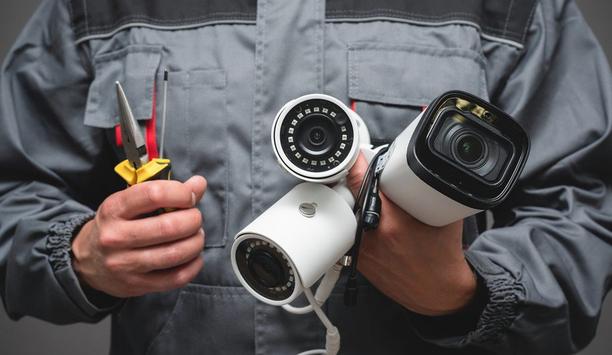
How to lower labour costs when installing video surveillance
Download
Total cost of ownership for video surveillance
Download
The truth behind 9 mobile access myths
Download
5 surprising findings from OT vulnerability assessments
Download
Guide for HAAS: New choice of SMB security system
Download
Precision and intelligence: LiDAR's role in modern security ecosystems
Download
Integrating IT & physical security teams
Download


Palm vein recognition
Download
The key to unlocking K12 school safety grants
Download
Selecting the right network video recorder (NVR) for any vertical market
Download
Physical access control
Download
Cybersecurity for enterprise: The essential guide to protecting your business
Download
















